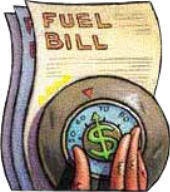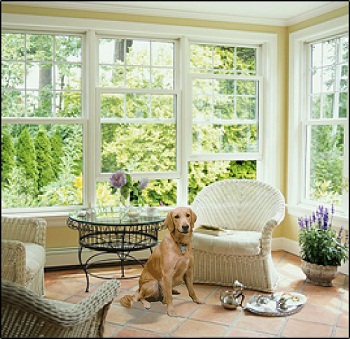Green Tips on What Does Going 'GREEN' Mean?
GREEN is a term now widely used to describe buildings designed and constructed with a minimal negative impact on the environment and with an emphasis on conservation of resources, energy efficiency, and healthful interior spaces.
You wouldn’t buy a new car without knowing its “miles per gallon” rating. So why buy a home without a “home energy rating?”
A Whole-House Home Energy Rating is a comprehensive evaluation of the efficiency of the entire home. The homeowner receives a written report that includes a numeric score or “rating” of the home, plus recommendations for improvements that will reduce energy bills and make the home more comfortable. Knowing the energy rating of your home is like knowing the miles per gallon rating of your car.
The California Energy Commission has developed the California Home Energy Rating System (HERS) Program to cover every type of residence in California. This includes new and existing single-family homes and multifamily buildings of three stories or less. Energy Commission-approved HERS Providers train, certify, and oversee a new type of service professional known as a “California Whole-House Home Energy Rater.”
Question: Do Your Monitor Your Meter and Match-Up Your Utility Bill?
Utility workers make mistakes just like the rest of us, and when they make mistakes reading your meter, it can be costly. While you notice a big error on your utility bill, you may not catch more subtle errors.
Make sure you’re only getting charged for the electricity you use by comparing the meter reading on your utility bill to what you see on your meter.
If the amount on your meter is lower than the one on your bill, that’s a dead giveaway that you’re being overcharged.
Lower the Thermostat:
Each degree you lower the thermostat on your heating system decreases your fuel bill by 3 percent. Going from 72 degrees down to 68 degrees doesn’t matter much in terms of comfort, but it can save up to 12 percent on your heating bill.
If you’re using a coil-type thermostat, you’ll get more accurate readings if you clean it.
Pop off the thermostat cover and blow or gently wipe away the dust.
 FOR HEAT
FOR HEAT
6 a.m. to 9 a.m. = 68 degrees
9 a.m. to 5:30 p.m. = 60 degrees
5:30 to 11 p.m. = 68 degrees
11 p.m. to 6 a.m. = 60 degrees
FOR AIR CONDITIONING
6 a.m. to 9 a.m. = 75 degrees
9 a.m. to 5:30 p.m. = 80 degrees
5:30 p.m. to 11 p.m. = 75 degrees
11:00 p.m. to 6 a.m. = 80 degrees
Ceiling Fans:
Ceiling fans are everywhere in warm-weather climates. Spinning counterclockwise, they move air around the room. Not all energy experts feel it’s a clever idea to use them in the heating season (doubters say they cool the air too much), but the fans do help bring heated air down to earth in rooms with cathedral or high-sloped ceilings. However, that’s only if you slide the reversing switch on the side of the motor housing to the winter (clockwise) position. Then run the fan at its slowest speed. If you can’t reverse the blade rotation or if you think the fan is cooling off the room too much, leave it off.
Windows:
Energy-efficient windows incorporating advanced technologies like low-emittance (low-E) glass coatings, gas filler between layers, and composite framing materials keep heat inside in the winter and outside in the summer.
 Heat loss or gain through windows accounts for 10 to 25 percent of your overall heating bill. Window film can be retrofitted to existing windows to reduce heat gain due to solar radiation and provide a low-cost cooling load reduction. Window films are thin layers of polyester, metallic coatings, and adhesives that save energy by limiting both the amount of solar radiation passing through the windows and the amount of internal heat escaping through windows. They can be applied directly to the interior surfaces of all types of glass and last 7 to 12 years.
Heat loss or gain through windows accounts for 10 to 25 percent of your overall heating bill. Window film can be retrofitted to existing windows to reduce heat gain due to solar radiation and provide a low-cost cooling load reduction. Window films are thin layers of polyester, metallic coatings, and adhesives that save energy by limiting both the amount of solar radiation passing through the windows and the amount of internal heat escaping through windows. They can be applied directly to the interior surfaces of all types of glass and last 7 to 12 years.
Typically, in the heating season, more heat escapes from most windows than comes in from the sun (on a 24-hour basis); the extent depends on the local climate and the R-value of the window. Window films can help reduce this costly heat loss by reflecting indoor radiant heat back into the room.
In the cooling season, even when drapes and blinds are closed, much of the sun’s heat passes through the glass into the room. Window films address this problem by reducing solar heat gain at the window. In short, window films save energy by reducing radiation and other forms of heat transfer through windows, allowing better balance in heating and cooling systems and by providing opportunities for HVAC downsizing.
There are several economic considerations regarding window film installations. For old, drafty, single-pane windows, complete window replacement is another option.
Although this option is more expensive than window film installation, it may be more appropriate depending on your window condition. It may be the most cost-effective to install window films only on the south and west sides of the building.
Window films typically cost between $1.35 and $3 per square foot, installed.
Improperly installed films can, however, bubble, crack, peel, or even cause the glass to crack, so it is worthwhile to buy films with a material and installation guarantee of 5 to 10 years.
Insulation:
Increasing the amount and R-value of insulation is a cost-effective way to save energy and help reduce heating and cooling bills, which account for at least half of energy use in the home. Sprayed insulation made of foam, cellulose or wool is an alternative to traditional glass fiber batting.
Vinyl siding on exterior walls saves money on installation and maintenance; fiber-cement siding is termite- and water-resistant and warranties to last 50 years.
Selecting more efficient, correctly sized heating, cooling and water heating equipment saves money.
Tank-less water heaters provide hot water on demand at a preset temperature rather than storing it, which reduces or eliminates standby losses.
Geothermal heat pumps work with the Earth’s renewable energy and can also heat water.
 Solar power is the conversion of sunlight into electricity, either directly using photovoltaics (PV), or indirectly using concentrated solar power (CSP). Concentrated solar power systems use lenses or mirrors and tracking systems to focus a large area of sunlight into a small beam.
Solar power is the conversion of sunlight into electricity, either directly using photovoltaics (PV), or indirectly using concentrated solar power (CSP). Concentrated solar power systems use lenses or mirrors and tracking systems to focus a large area of sunlight into a small beam.
Flooring:
In addition to natural wood, flooring choices include low-VOC (volatile organic compounds) carpets for better indoor air quality, laminates that successfully mimic scarce hardwood, and linoleum, a natural product making a design comeback.
Appliances:
The energy efficiency of refrigerators and freezers has tripled over the last three decades because they have more insulation, advanced compressors, better door seals, and more accurate temperature controls.
Front-loading washers use about 40% less water and half the energy of conventional models. Energy Star®-rated appliances save an average of 30 percent over Standard models.
Trees:
Tree preservation reduces landscaping and future energy costs and helps provide winter windbreaks or summer shade. Additional landscaping improves the environment even more: One tree can filter 60 lbs. of pollutants for the air each year.
Toilets:
New toilets have redesigned bowls and tanks that use less water, but function more efficiently than first-generation low-flow models. Some use pumps for supplementary water pressure. Advanced shower and sink faucet aerators provide the same flow regardless of pressure to reduce water use and the energy required to heat it.
Change Your Furnace Filter:
If you have a forced-air system, changing the furnace filter can save you some energy (up to 5 percent) and keep the dust down in the house. The system will last longer and be less likely to break down. The most popular 16 X 20-inch duct filter costs around 50 cents when bought by the box. Change them monthly during the heating season. Measure your air filter before shopping; they range in size from 12 X 12 inches to 30 X 30 inches. An alternative to swapping out the replacement filter is to use washable filters (around $20 each). With care, they can last five years.
Automobile:
Your fuel costs. Pollution. Our country’s dependence on foreign oil. The vehicle you choose to drive and how you drive it affects all of these issues. To minimize these effects, please look at these ways to improve your vehicle’s fuel efficiency.
Drive sensibly. Aggressive driving (speeding, rapid acceleration, and braking) wastes gasoline.
- Consider buying a highly fuel-efficient vehicle. A fuel-efficient vehicle, a hybrid vehicle, or an alternative fuel vehicle could save you a lot at the gas pump and help the environment. See the Fuel Economy Guide for more on buying a new fuel-efficient car or truck.
- Combine errands into one trip. Several short trips, each one is taken from a cold start, can use twice as much fuel as one trip covering the same distance when the engine is warm.
- Replace clogged air filters to improve gas mileage by as much as 10% and protect your engine.
- Get regular engine tune-ups and car maintenance checks to avoid fuel economy problems due to worn spark plugs, dragging brakes, low transmission fluid, or transmission problems.
- Keep tires properly inflated and aligned to improve your gasoline mileage by around 3.3%.
- Use the grade of motor oil recommended by your car’s manufacturer. Using a different motor oil can lower your gasoline mileage by 1%-2%.
- Check into telecommuting, carpooling, and public transit to cut mileage and car maintenance costs.
- Reduce drag by placing items inside the car or trunk rather than on roof racks. A roof rack or carrier provides additional cargo space and may allow you to buy a smaller car. However, a loaded roof rack can decrease your fuel economy by 5%.
- Clear out your car, extra weight decreases gas mileage. Use air conditioning only when necessary.
- Using cruise control on the highway helps you maintain a constant speed and, in most cases, will save gas.
- When you use overdrive gearing, your car’s engine speed goes down. This saves gas and reduces wear.
- Avoid high speeds. Above 60 mph, gas mileage drops rapidly. The fuel economy website shows how driving speed affects gas mileage.
- Aggressive driving (speeding, rapid acceleration, and hard braking) wastes gas. It can lower your highway gas mileage 33% and city mileage 5%.
- Idling gets you 0 miles per gallon. The best way to warm up a vehicle is to drive it. No more than 30 seconds of idling on winter days is needed. Anything more simply wastes fuel and increases emissions.





